
| Specifications |
| Publisher: ADVAITA ASHRAM KOLKATA | |
| Author Trans By Swami Gambhirananda | |
| Language: English | |
| Pages: 847 | |
| Cover: Hardcover | |
| 8.4" X 5.5" | |
| Weight 640 gm | |
| Edition: 2023 | |
| ISBN: 9788175050419 | |
| IDE159 |
| Delivery and Return Policies |
| Ships in 1-3 days | |
| Returns and Exchanges accepted within 7 days | |
| Free Delivery |
He who finds inaction in action, and action in inaction, he is the wise one among men; he is engaged in yoga and is a perfomer of all actions!
The publication of this edition of the Bhagavadgita by us fulfils a long-felt need, namely, to make available to the public interested in Advaita Vedanta a faithful English translation of Sankaracarya's commentary on this sacred scripture. It is well known that the Gita is one of the constituents of the prasthana-traya, three source-books, of the Vedanta Darsana. It is called the smrti-prasthana, as it forms a part of the great epic, the Mahabharata.
The translator, Swami Gambhirananda, one of the Vice-Presidents of the Ramakrishna Math and the Ramakrishna Mission, needs no introduction to those who have studied his Eight Upanisads (in two volumes, each of which is also separately published), his Brahma-Sutra-Bhasya of Sankaracarya, published nearly two decades back, and his Chandogya Upanisad, published recently-all by the Advaita Ashrama, Mayavati. He now offers this translation of the bhasya of Sankaracarya on this very important scripture, Bhagavadgita, which, as the translator remarks in his valuable Introduction, 'is ranked among the greatest religious books of the world'. In this informative and scholarly Introduction, he has discussed in brief such subjects as the date of the Mahabharata war, which provided the occasion for the birth of the Gita, the historicity of the Gita on other countries, the date of Sankaracarya-well documented and fortified by the views of several savants, both of the East and the West, and by referring to inscriptions.
The method followed in translating this bhasya is the same as in his translation of the Upanisads. With the publication of this book, the present translator has done the monumental work of rendering into English Sankaracarya's bhasya on the entire gamut of the prasthana-traya, with the only exception of the Brhadaranyaka Upanisad, the commentary on which by Sankara was translated by Swami Madhavananda of revered memory and first published by us in July 1934.
It may be noted that, while the slokas are in devanagari, only the English rendering of such expressions as Sribhagavanuvaca, Arjuna uvaca, etc. are given in the book. A very useful feature of this edition of the Bhagavadgita is the inclusion of a 'Word Index' to the entire text, apart from an Index to the first words of the slokas, which, we believe, will be found helpful to both scholars and students alike. It is our earnest hope that this edition of the Gita will be warmly welcomed and received by those interested in Sankaracarya's commentary on it.
The scene of the delivery of the Bhagavadgita (The Song Divine), also known briefly as the Gita, by Sri Krsna to Arjuna is laid on the battlefield of Kuruksetra where the Pandavas and the Kauravas had assembled their armies for war. Scholars differ as regards the date of this battle, though they are inclined to think that it was a historical event. According to tradition the battle was fought at the end of the Dvapara-yuga. The next yuga, viz the Kaliyuga, is believed to have started on 18 February 3102 B.C., when Pariksita, grandson of Arjuna ascended the throne of the Kauravas at Hastinapura. (The History and Culture of the Indian People, Bharatiya Vidya Bhavan, vol. I, p. 308) Karandikar says that the battle was fought in 1931 B.C., while Prof. Sengupta argues that it was fought in 2566 B.C. C. V. Vaidya holds that the was fought in 3102 B.C.
As Dhrtarastra was born blind, he could not rule the kingdom. So his younger brother Pandu became the Ruler. When Pandu died his sons were too young as also were Duryodhana, the eldest son of Dhrtarastra, and his younger brothers. Hence, Bhisma, the oldest member of the family, managed the affairs of the State. When the young boys came of age Duryodhana wanted to become the King by ousting Yudhisthira through foul means. But public opinion was in favour of Yudhisthira. So, in order not to antagonize the officials and the people, Bhisma advised Dhrtarastra to divide the kingdom between his sons, referred to as the Kauravas, and Pandu's sons called the Pandavas. This advice was followed. Accordingly the former ruled from Hastinapura and the latter from Indraprastha for thirty-six years. But Duryodhana was jealous of the prosperity of the Pandavas, and to ruin them he invited Yudhisthira to a game of dice, which resulted in the banishment of the Pandavas under the condition of living in the forest for twelve years and one year incognito. After the stipulated period Yudhisthira claimed his portion of the kingdom, but Duryodhana refused, and this led to the battle of Kuruksetra. Yudhisthira had four brothers Bhima, Arjuna, Nakula and Sahadeva, Arjuna was considered the mightiest among the contemporary warriors. Sri Krsna, though Himself a formidable warrior and regarded as an Incarnation of God, vowed not to take up arms on either side, but agreed to become the charioteer of Arjuna. Through the political sagacity and able advice of Sri Krsna the result of the battle went in favour of Yudhisthira, who ascended the throne.
The battle is described in all its details in the great epic Mahabharata. And the Gita which forms chapters 23 to 40 of the Bhismaparva of this epic must be as old; Radhakrishnan points out that the Mahabharata contains references to the Gita. (Indian Philosophy, vol. I, p. 523.) Scholars are at variance about the date of this voluminous epic. They ascribe to it a date much later than that of the battle, and opine that it underwent many additions and alterations in subsequent ages. According to them the Gita also suffered the same fate. R.C. Dutta thinks that the Mahabharata was first written in the twelfth century B.C. Buhler and Kriste in their book, Contributions to the Study of the Mahabharata assign the present form of the epic to the third century A.D. But according to Radhakrishnan the epic took its present form at least in the fifth century B.C., whereas it might have been first written in the eleventh century B.C. (lbid p. 480).
Some of the western thinkers were of the opinion that the Gita was written after Jesus Christ and the idea of devotion was borrowed from him. But the Encyclopaedia of Religion and Ethics remarks, 'it is not certain that portions of this poem, in which the doctrine of bhakti, or fervent faith, is taught, are pre-Christian, and therefore itself is of indigenous Indian origin.' (Vol. vi, p. 696.) Not merely the devotional portions but the book as a whole is not only pre-Christian, it is pre-Buddhistic as well.
That the Gita is pre-Buddhistic follows from the fact that it does not refer to Buddhism. Some scholars believe that the mention of nirvana six times in the Gita is a clear indication of its post-Buddhistic origin. But the word nirvana in the Gita occurs compounded either with brahma as Brahma-nirvanam-meaning identified with or absorbed in Brahman-, or with paramam as nirvana-paramam, which means culminating in Liberation. The Buddhistic nirvana, on the other hand, is used in the sense of being blown out or extinguished. This word also occurs elsewhere in the Mahabharata in the sense of extinction. So, the conclusion is that the Buddhists borrowed the word nirvana from the earlier Hindu literature. Furthermore, the construction of many sentences as also archaic forms of words in the Gita does not follows the grammatical rules of Panini (c. sixth century B.C.). Besides, the word yoga is used in the Gita in a much wider sense than it is in the Yoga-Sutras of Patanjali, who followed Panini 100 or 150 years later. Telang is of the opinion that the Gita was written earlier than 300 B.C., while R.J. Bhandarkar holds that it must have been written earlier than the fourth century. (Vaisnavism and Saivism, p. 13) Radhakrishnan, however, goes further backward to fifth century B.C. According to Dr. Dasgupta it must have been composed earlier than Buddha's advent, but in no case later than that. Noticing the similarity of language among the Mundaka Upanisad, Svetasvatara Upanisad and the Gita, some scholars have concluded that the Gita belongs to the later Upanisadic age. In fact, the colophons in the Gita mention that it is an Upanisad (bhagavad gitasu-upanisatsu).
Though, as suggested by some scholars, Krsna of the Rg-veda (8.96.13-15), who lived on the banks of Amsumati (Yamuna) and fought against Indra, might have been a tribal god, the Krsna of the Mahabharata, otherwise known as Vasudeva (son of Vasudeva and Devaki), must have been a historical person, honoured as an incarnation of Visnu or Narayana. Megasthenes (320 B.C.), the Greek. Ambassador to the court of Chandragupta, mentions that Heracles was worshipped by Sourasenoi (Surasenas) in whose land were two great cities-Methora (Mathura) and Kleisobora (Krsnapura). Scholars identify Heracles (Harikulesa) with Krsna. The Kausitaki Brahmana refers to Him as a descendant of Angirasa (30.9), and the Chandogya Upanisad (3.17.6) says that Krsna, son of Devaki, was taught by Ghora Angirasa. Some scholars find a similarity between the teaching of Krsna (Gita, 16.1-3) with Ghora's teaching: 'Then, these that are austerity, charity, straightforwardness, non-injury and truthfulness are the payments made to the priests' (Ch. 3.17.4). Besides, Ghora's use of the word yajna (sacrifice) in a metaphorical sense finds its echo in the fourth chapter of the Gita (verses 24-33). Finally, Ghora's conclusion of his teaching with, 'At the time of final departure one should think, "Thou art the indestructible, Thou art the Immovable, Thou art the essence of the Vital Force", has similarity with the verses 11 to 13 of the eighth chapter of the Gita. In time, Vasudeva became the central figure of the Bhagavata cult. His name is mentioned in Panini's grammar (4.3.98). The Besnagar (Vidisa) inscription (180 B.C.) mentions the erection of a column with a Garuda's image on it, in honour of Vasudeva by Heliodorous, a Bhagavata and a resident of Taxila. In the Buddhist book Niddesa (fourth century B.C.) included in the Pali Canon, there is a reference to the worshippers of Vasudeva and Baladeva among others. Old Jaina literature also refer to Krsna (Kanha). All these facts go to prove that Krsna was a pre-Buddhistic personality.
According to the recension of the Gita commented on by Sankaracarya, the number of verses is 700. But there is evidence to show that some old manuscripts had 745 verses. The Gita published in Srinagar, Kashmir, with the annotation of Abhinavaguptacarya, contains the same number of verses. Other manuscripts have been discovered with variations both in the number of verses and the readings. Pusalker is of the opinion that 'the additional stanzas effect no material addition; nor do they create any differences in the teaching or argument. (Studies in Epics and Puranas, p. 144) He further remarks that 'Sankaracarya's testimony for the text of the Bhagavadgita is earlier than that of any other MS or commentator.' (ibid. p. 147.) However that may be, after sankaracarya wrote his Commentary, the Gita has taken a definite form with 700 verses, so far at least as the general public is concerned.
The Gita is ranked among the greatest religious books of the world, and in India it occupies a position next only to the Upanisads. In fact, it is considered as a summing up of the Upanisads; in certain places it quotes from them almost verbatim. There is a commonly known verse which says, 'All the Upanisads are cows, the milker is Sri Krsna, the calf is Arjuna, the enjoyers are the wise ones and the milk is the fine nectar that the Gita is.' The book has been translated into all the widely spoken languages in India as also into the principal languages, of the world. As early as the time of Akbar (1556-1605) the book was translated into Persian separately by Abu-'1- Fazl and Faizi.
About the Bhagavad-Gita, the Encyclopaedia Britannica (vol. viii, pp. 937-8) writes: 'The influence of the Bhagavad-Gita has been profound. It was a popular text open to all who would listen and fundamental for all later Hinduism.
The importance of the Gita for the Hindu public is proved by the fact that almost all the religious leaders following Sankaracarya have interpreted the Gita according to their own schools of thought. Among them Ramanujacarya (1199-1276), Vallabhacarya (1479), Kesava Kasmiri, a follower of Nimbarkacarya (1162), Vijnana Bhiksu, Jnaneswar and Tukaram wrote commentaries or elucidations on the Gita. In modern times also, such annotations have been written by B.G. Tilak, Mahatma Gandhi and Sri Aurobindo among others.
About the influence of the Gita on other counties and religions Radhakrishnan writes, 'The Gita has exercised an influence that extended in early times to China and Japan, and lately to the lands of the West. The two chief works of Mahayana Buddhism, Mahayana-sraddhotpatti (The Awakening of Faith in the Mahayana) and Saddharma-pundarika (The Lotus of the True Law) are deeply indebted to the teaching of the Gita. It is interesting to observe that the official exponent of the "German Faith", J.W. Hauer, a Sanskrit scholar who served for some years as a missionary in India, gives to the Gita a central place in the German faith.' (Bhagavadgita, p. 11.) Dara Shuko was enamoured of the Gita. We have already indicated that the Gita traveled to Persia during the Mughal Age. In recent times it has been appreciated by eminent men and scholars like Dr. L.D. Barnett, Warren Hastings, Charles Wilkins (who translated the Gita into English in 1758), Carlyle and Aldous Huxley.
It is not necessary to present here the gist of the Gita, for this will be apparent to those who read it as also the present translation. Suffice it to say that although many western scholars believe that the Gita is a loose collection of thoughts of different schools, Madhusudana Saraswati divides the Gita into three sections of six chapters each, dealing successively with Karma-yoga, Bhakti-yoga and Jnana-yoga, the first leading to the second and the second to the third. But Ananda Giri holds that the three sections are concerned with the ascertainment of the true meaning of the great Upanisadic saying, 'Thou art That'. His view has been presented in the footnotes of the present work. Sankaracarya makes no such division, but says that spiritual unfoldment proceeds along the following stages: practice of scriptural rites and duties with a hankering for results; practice of the same as a dedication to God without expecting rewards for oneself; purification of the mind or moral excellence along with upasana (devotion to and meditation on the qualified Brahman); acquisition of knowledge from a teacher and the scriptures, followed by renunciation of all rites and duties (monasticism), which makes one fit for steadfastness in that knowledge; steadfastness in that knowledge; removal of ignorance and self revelation of the supreme Brahman, which is the same as Liberation. (See Sankaracarya's Commentary on 5.12; his introduction to 5.27, 18.10; and Commentary on 18.46 and 18.49.) He thus reveals a unity of purpose of the book as a whole.
In the preparation of this book we have been helped by Swamis Gabhirananda and Atmaramananda. In general, we have followed the Gita Press (Gorakhpur) edition of the text and the Commentary. Important variations in reading have been pointed out in the footnotes. Other footnotes on the text and the Commentary are based on Ananda Giri, unless and otherwise stated.
| Introduction by the Translator | xiii | |
| Invocation | 1 | |
| Introduction by Sri Sankaracarya | 2 | |
| Chapter 1: | The Melancholy of Arjuna | 9 |
| Chapter 2: | The Path of Knowledge | 30 |
| Chapter 3: | Karma-Yoga | 122 |
| Chapter 4: | Knowledge and Renunciation of Actions | 175 |
| Chapter 5: | The Way to Renunciation of Actions | 232 |
| Chapter 6: | The Yoga of Meditation | 270 |
| Chapter 7: | Jnana and Vijnana | 315 |
| Chapter 8: | Discourse on the Immutable Brahman | 341 |
| Chapter 9: | The Sovereign Knowledge and Mystery | 367 |
| Chapter 10: | The Divine Glory | 397 |
| Chapter 11: | Revelation of the Cosmic Form | 428 |
| Chapter 12: | Bhakti-Yoga | 473 |
| Chapter 13: | Discrimination between Nature and Soul | 494 |
| Chapter 14: | The Classification of the Three Gunas | 567 |
| Chapter 15: | The Supreme Person | 591 |
| Chapter 16: | The Divine and the Demoniacal Attributes | 615 |
| Chapter 17: | The Three Kinds of Faith | 634 |
| Chapter 18: | Monasticism and Liberation | 656 |
| Index to First Words of the Slokas | 773 | |
| Index to Words | 786 | |
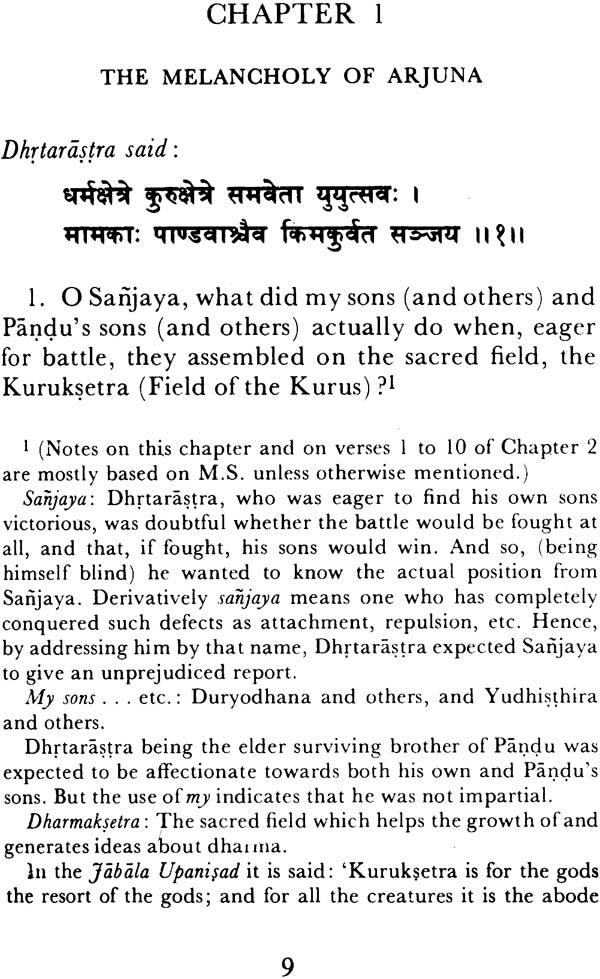
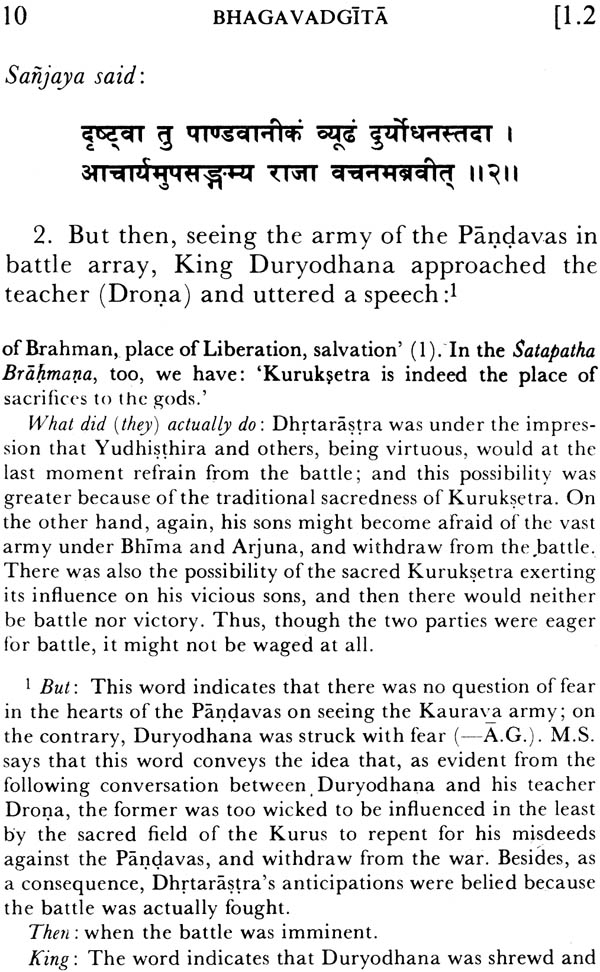
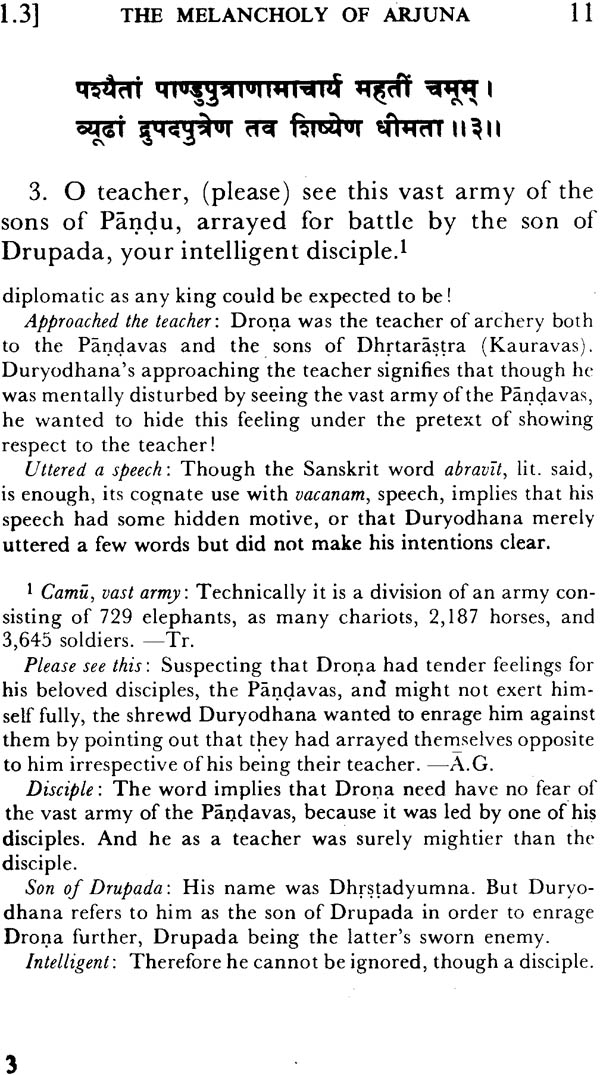

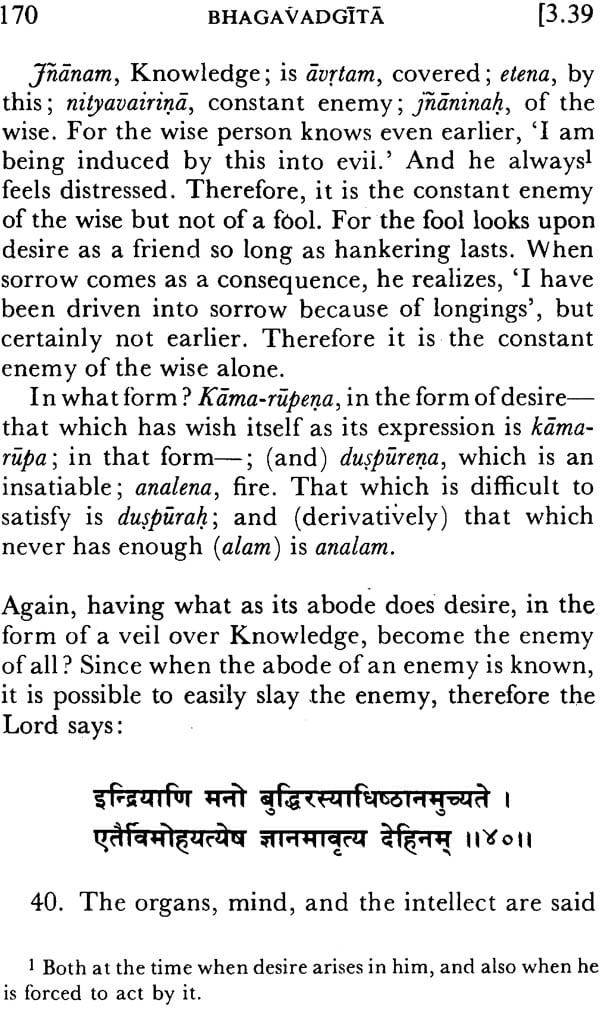
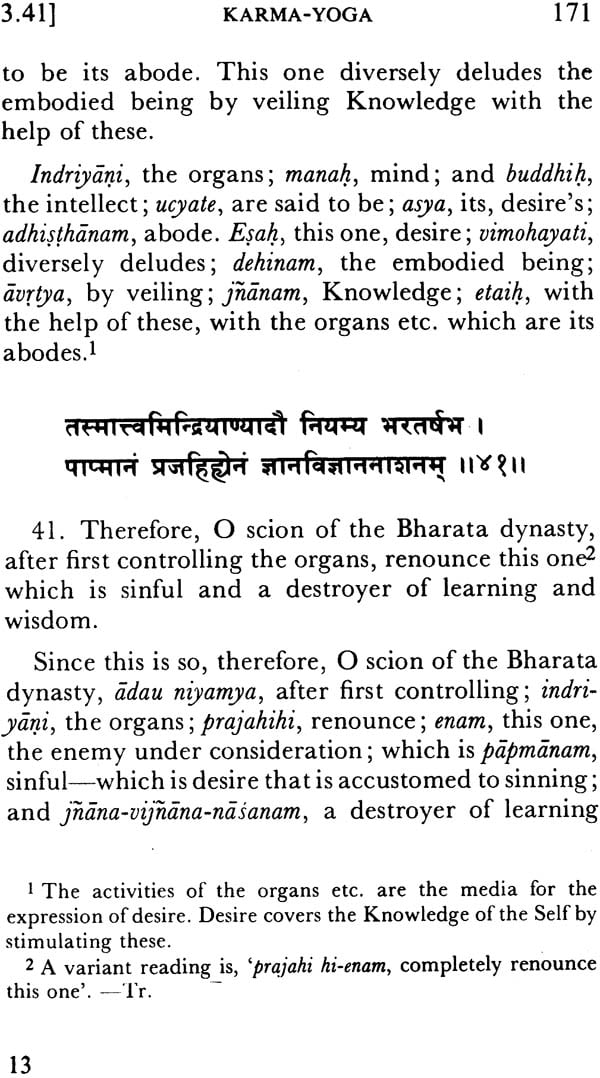
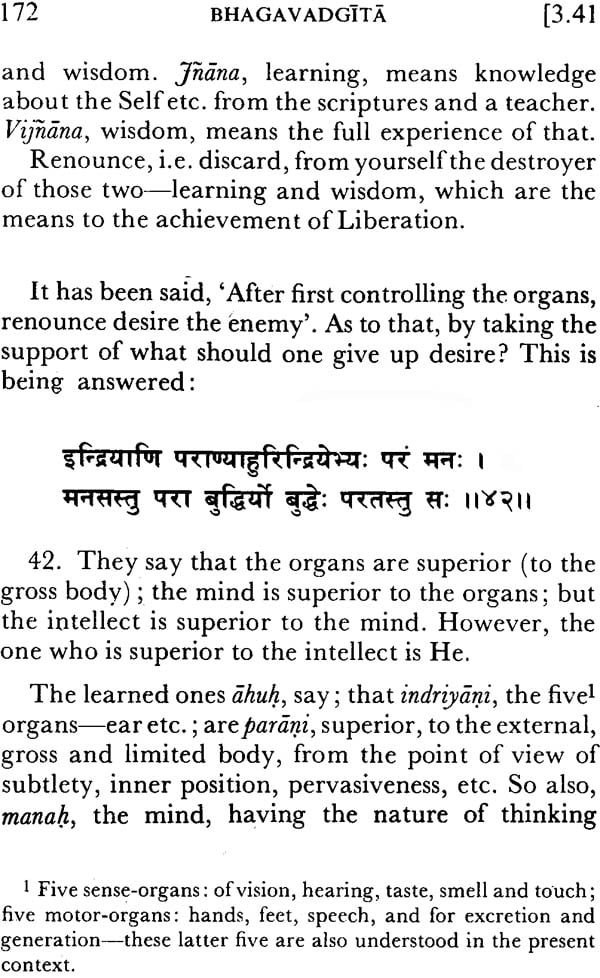

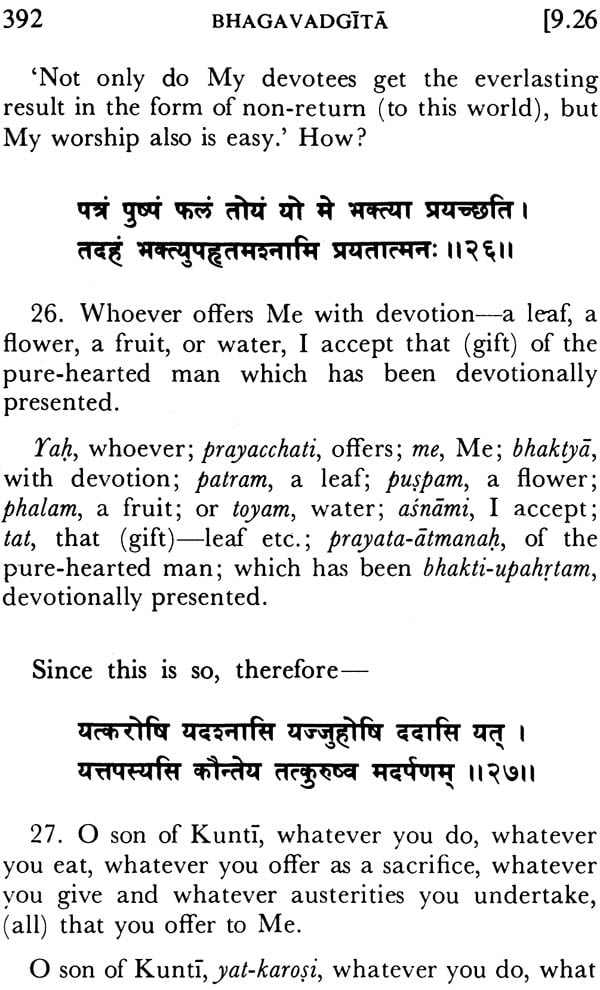
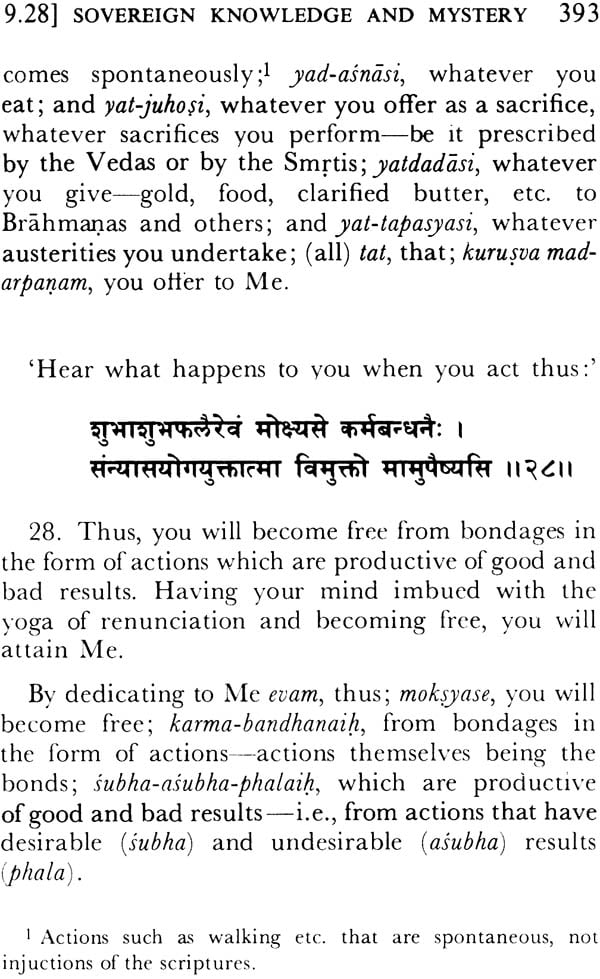
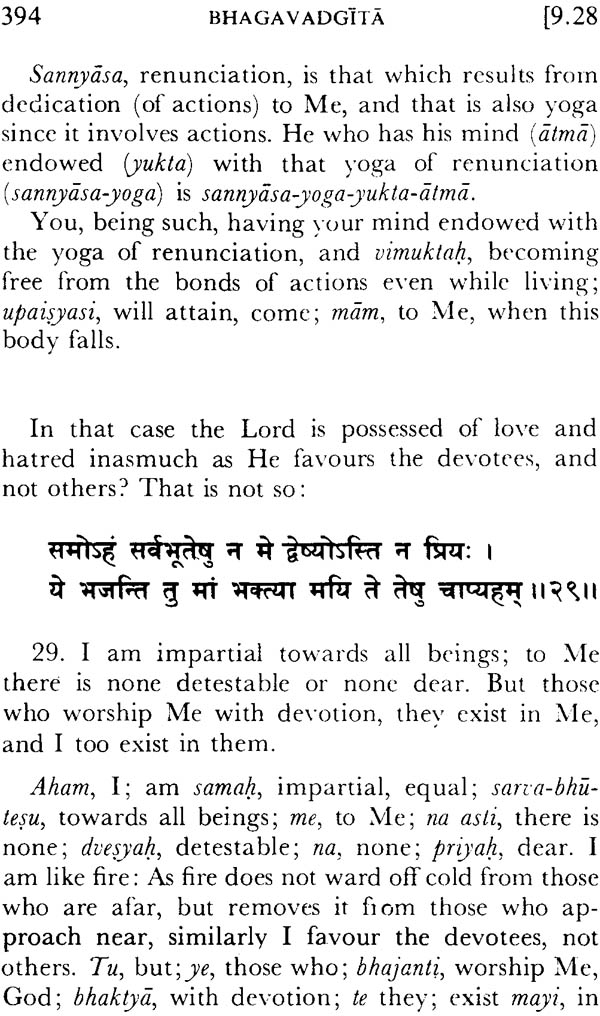
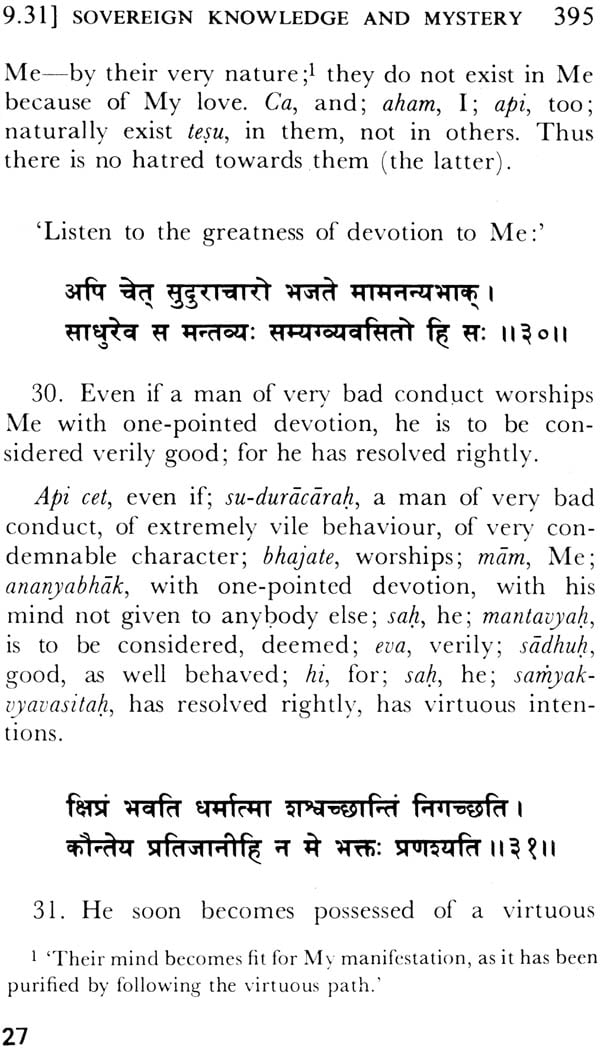

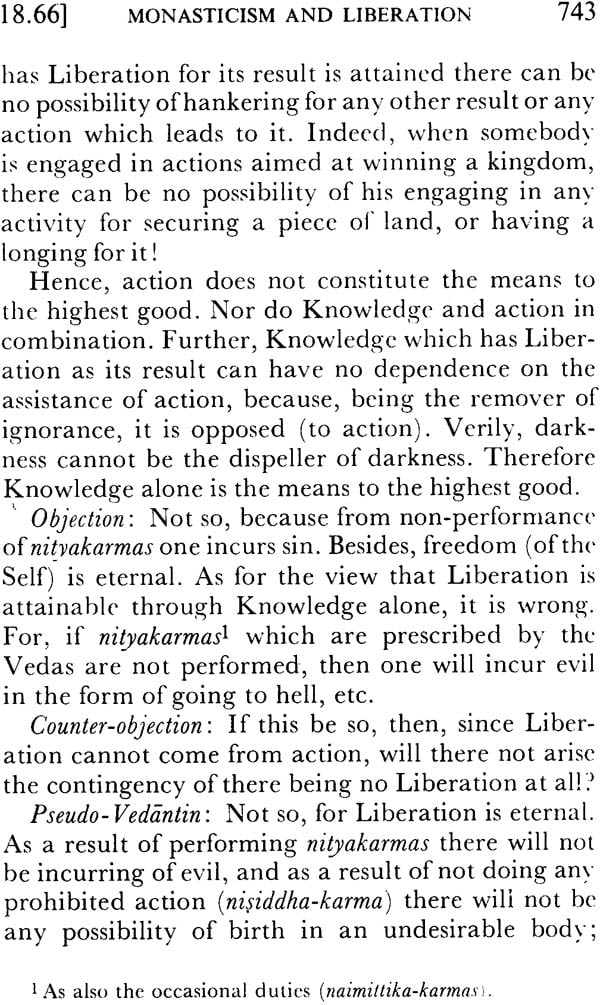
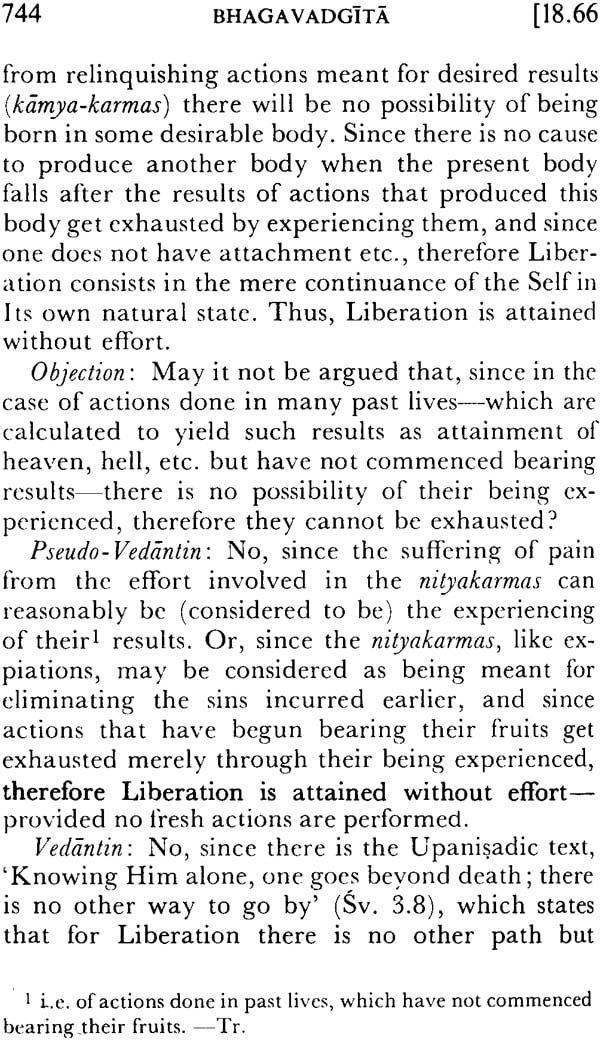

Of Related Interest:
Life of Shankaracharya - The Adventures of a Poet Philosopher
Click Here for an Exhaustive Collection of Books Relating to Shankaracharya
Send as free online greeting card
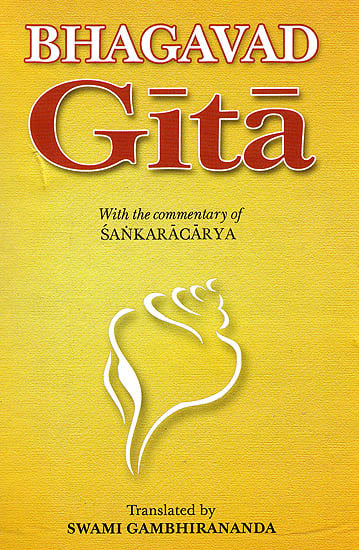
Visual Search